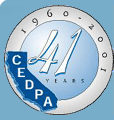

DataBus - Vol 41 No. 2: February-March, 2001
|
California Takes the E-rate
A Summary of E-rate news and events
The times (they are) a changin' These are the times of change with several large-scope education technology initiatives, federally with E-rate and Internet filtering, and, in California, with several telecommunications items that may involve the California Public Utilities Commission (CPUC). By the time you read this, some will have been more clearly resolved.
E-rate The end of the Year 4 filing window for the notorious Form 471 closed January 18. Preliminary reports from the Schools and Libraries Division (SLD) personnel who administer the federal E-rate program are that more Form 471s were received than in Year 3. When the tallies are released, we will have some idea how much of the "priority one" funding (telecommunications and Internet access) has been requested, thereby giving us a rough idea of how far down the discount scale the "priority two" funding may go (internal connections). Speculation says that applicants who are not at or very near the 90% discount level may not see internal connection funding in Year 4.At the SLD, the arrival of a new presidential administration is causing anxieties. The E-rate program just underwent an audit / inspection by the General Accounting Office (GAO), and the results were not unexpected -- general approval, but weaknesses in the accountability aspects. Various proposals to revamp the E-rate program are now being released and debated. If the E-rate program is combined into other existing federal funding channels and/or into a state-level block grant type allocation, it will mean a radically different E-rate program. The public school sector plus unexpected allies (nonpublic schools and telcos) appear to be generally united in support of retaining the program, if not in its present form, then at least in a manner that does not cause current recipients to find their network connectivity soon unaffordable.
Internet Filtering and E-rate HR4577 mandates Internet filtering and other supervisory steps for those receiving federal funds (ESEA, E-rate). The California Department of Education (CDE) has a website, maintained by the Education Technology Office, with a graphical overview of the filtering issue plus an annotated version of the full law (www.cde.ca.gov/erate, under "News" go to "Current").Estimates are that about 60% of public schools have some type of filtering in place, but since filtering is not an eligible service under current E-rate rules, Year 4 applicants presumably did not apply for discounts on that service. Yet, some did, either inadvertently or gambling that it would become eligible. The Federal Communications Commission (FCC) has released tentative material relative to the Internet filtering law for public comment, and they are to have finalized their rules by April 20, during the period that the first "waves" of E-rate funding commitment letters begin to arrive from the SLD. October 28 is the generally recognized last day for E-rate recipients to certify compliance with the new law (120 days after the "first" program year, which is E-rate Year 4, starting July 1). Complicated? Yes. Will it change between now and then? Probably.
CPUC may assist on some old and new issues The California Public Utilities Commission (CPUC) or its staff may be looking into several issues affecting public K-12 telecommunications deployment and billing. One is the appearance of "911" charges on telephone bills paid by public K-12 schools; we may be exempt from these charges. Another may be the related matter of exemption from most taxes and some surcharges on telephone bills. Check your bills. If you see excise tax or local (municipal, city) taxes on the bill, it may be appropriate to contact your service provider to see about the process to determine your exemption status. Most service providers routinely adjust their billing programs for public K-12 when services are ordered, but it is not a 100% surety.The California Teleconnect Fund (CTF), California's E-rate sibling, does not currently provide the 50% discount for services above the DS3 level, but Pacific Bell has submitted a request to the CPUC for that to occur. If this is approved (it would presumably apply to all service providers), those needing bandwidth in larger amounts would be able to save considerably (50%) for these recurring charges. One question will be whether inclusion of such costly circuits will have an adverse effect on the CTF funding pool. In an attempt to bring some order to what is widely regarded as an unacceptable situation regarding reconciling E-rate and CTF discounts "stacked" together on telephone bills and reports, many cooperative efforts are underway to arrive at a statewide standard. Some E-rate recipients who have been audited by the SLD have simply been unable to verify how and when certain discounts are being applied, even with extensive help from their telco. Within the telco community, different service providers are taking different approaches, but California stands alone in the way it concurrently and retroactively attempts to account for simultaneous (E-rate and CTF) discounting.
Van Wilkinson is with the California Department of Education Educational Technology Office. He may be reached at (916) 323-4709 or by e-mail at
|
CEDPA